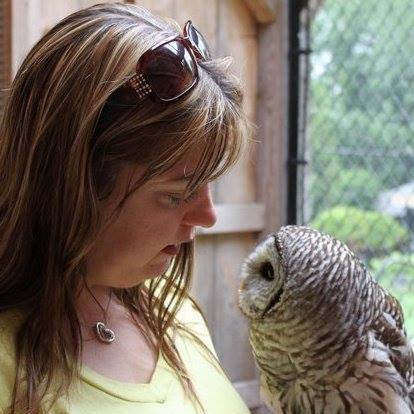Angela MacAloney-Mueller is St. Mike’s Physical Plant Coordinator. She’s been a part of the USMC community since August 1994, and notes that the comfort of students and staff are her top priority. She is, you’ll see, an avid birder.
Bird Nerd on Campus

I still remember the first time I visited the campus of the University of St. Michael’s College. It was for a job interview in July of 1994. With the luscious greenery, the full-grown trees and beautiful flowers, the grounds took my breath away. I thought to myself as I was leaving the campus, “Yes, I would like to work here.” Social media accounts for the university often use the hashtag #oasisinthecity and, as it turns out, we humans are not the only species who think so.
Some migratory birds travel thousands of miles twice a year during spring and fall migration. Toronto is on a major migratory flyway, and every spring the nighttime skies are filled with thousands of birds coming north for the summer to set up territory, find a mate and raise young, all before the long journey home. The city, and the campus grounds themselves, with their close proximity to Lake Ontario, are a perfect resting spot for those birds after a long night of travel.
I was working at the Pontifical Institute of Medieval Studies when I started birding more than 20 years ago. I’ve had a couple of lifers at work (a lifer is what it’s called when you see a bird for the first time). The campus gave me my first Oven Bird and Yellow-bellied Sapsucker. The spring offers a chance to see a wide variety of summer migrants, including Baltimore Orioles, Indigo Buntings, Scarlett Tanagers, and so many others. Many of the migratory birds will continue further north to the boreal forest, but a few do stay in and around the Toronto area, like the feisty red-winged blackbird.
Every spring I get work orders regarding the “attack bird” on campus. It seems the last few years a pair of red-winged blackbirds have thought the grounds lovely enough to build a home and raise young. The male is a fierce protector and will often swoop at people if they get too close to their nest—or, in this case just walk along the path. It is illegal to tamper with a migratory bird or its nest, but we have posted signs to warn people of what may happen. I have a lot of respect for the males: I’ve seen one swoop at a bald eagle! Fortunately, the nesting season is short, only about two weeks, and then peace and harmony return to the grounds.
Over the years I have been able to share a little of my knowledge regarding birds on campus. A couple of our yearlong resident bird species come to mind. A former co-worker came to my office one spring morning to let me know that a baby sparrow had fallen from its nest and asked what should we do. He was flabbergasted when I said, “Put it back.” The old myth that a momma bird won’t take care of its young if it’s been touched by a human is alive and well. Birds have no sense of smell, so it is very safe to put them back in their nest if you are able, which we did that day. The chick’s eyes were not yet open, but as soon as we lifted it close to its nest under the Elmsley Hall walkway, it instinctively crawled back into its nest.
Another time, a don in Elmsley Hall called to let me know a student had a baby robin in her room because it couldn’t fly and wanted to know if I could help. We went to the student’s room, where I discovered she had a fledgling. When a baby bird first leaves the nest, it is called a fledgling and is unable to fly for a few days. The mother robin will hide her fledglings in shrubbery, where she we will return and feed them throughout the day. After explaining this to the student, we took the baby robin back outside where she had found it. It wasn’t long before momma robin was there to check on her baby, much to the relief of the student.
The St. Michael’s grounds play hosts to a variety of birds and wildlife year-round. When enjoying the flower gardens during the summer months around Brennan Hall you may see a ruby-throated hummingbird or monarch butterfly. The fall and winter months always bring the hawks to campus, where they help with pigeon control. Spring is the real star of the year though, with the many colourful songbirds and warblers passing through. The chorus of birds singing at dawn and dusk this time is joyful to hear, and I am sure wakes many of our students in residence.
I believe the variety of birds and wildlife add to the campus. Many times, I have seen the delight on a student’s face who has never seen a squirrel before. I’ve pointed out American goldfinches and downy woodpeckers to coworkers when walking from building to building. And it doesn’t matter how many times you see a northern cardinal, you are going to stop and stare at his brilliant red colouring.
Birding for me, as always been a source of stress relief. How lucky we are when on campus, that we can leave our office to walk to a meeting in another building or just to enjoy the grounds and surround ourselves in nature. The St. Michael’s campus truly is an oasis in the city.
Read other InsightOut posts.
